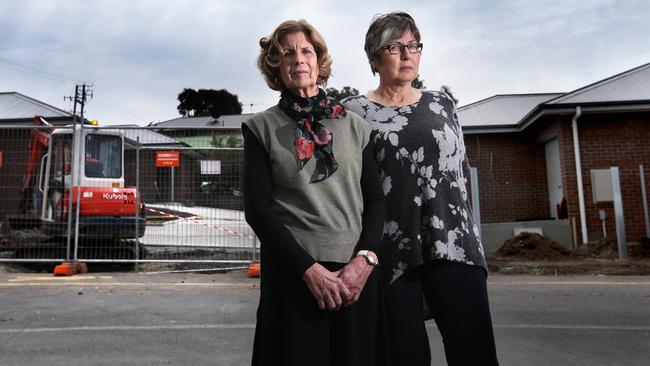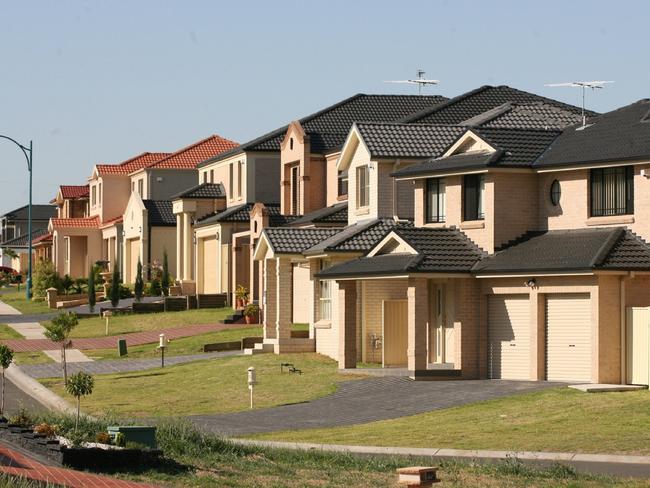Groups claim planning reform will come at high cost
HOBART is set to become home to the McMansion under the proposed new statwide planning scheme, community groups and experts warn.

MCMANSIONS and apartments are set to change the face of Hobart’s suburbs under the new statewide planning scheme, a growing number of opponents and experts are warning.
State planning provisions being developed would undermine the character of residential areas, silence community voices and threaten national parks, says a coalition of 20 groups backed by experts at the University of Tasmania and the RMIT.
The Liberal State Government came to power promising a simpler, cheaper and faster planning system and aims to have the Tasmanian Planning Scheme in place by the end of next year.
Planning Minister Peter Gutwein has argued that 80 per cent consistency can be achieved, improving on the present 15 per cent across the state’s 29 councils.
The move, which follows similar reforms interstate, is being backed by developers through the Property Council of Australia.
But a coalition of 20 community and environmental groups, including eight from the East Coast, has called a public meeting to highlight what they claim is a one-size-fits-all threat to the Tasmanian way of life.
“The Government’s got to go right back to the drawing board and get it right,” the Tasmanian Planning Information Network’s Anne Harrison said.
Among the coalition’s claims are:
CONSULTATION time was too short for the highly complex new rules.
HEIGHTS and densities will change the character of suburbs and increase traffic problems.
DEVELOPERS will be given a green light to build along coast and in national parks.
COUNCILS and communities will be less able to oppose development.
DEREGULATION will continue into the future, further weakening rules.
Central to the concerns are mainland-style residential zones where three-storey so-called “McMansions” can be built close to boundaries.
Smaller block sizes will mean more subdivision, more units and more traffic, the opposition groups say.

Ms Harrison said examples were already springing up near her home in Blackmans Bay under the Kingborough Municipality’s interim planning scheme introduced as a transitional step.
“The big house chews up most of the block because of a new building envelope, smaller block sizes and closer setbacks,” she said. “Classically in Blackmans Bay you had a house, a tree and a garden. Now, all demolished, cleared out, and we’ve got four units.
“We’re actually talking about whether people have the right to have a garden any longer.”
UTAS Distinguished Professor Jamie Kirkpatrick said the draft provisions document was too complex and weighted in favour of development.
“It’s basically a document that allows most forms of development in most places,” he said. “Most people in Tasmania don’t want three-storey buildings right on their fence.”
Tasmania’s new scheme will come in the wake of other states deregulating their planning rules over recent decades.
They focus on standardised zones applied across a state with mixed uses, such as residential and commercial, that were previously separated.
The emphasis is on cutting the need for permits where development meets the state’s minimum standards.
Interstate critics blame the new rules for the explosion in big new homes and residential tower blocks.
“Heritage houses are being demolished and large McMansions, very large houses, are being built in their thousands in Melbourne, or very poorly controlled multi-unit development,” said Professor Michael Buxton of the RMIT. “This planning scheme really poorly protects large residential areas right through Tasmania’s cities and towns from medium density but also medium-rise and ultimately high-rise.”
But Property Council Tasmanian executive director Brian Wightman said the reforms would finally address the long-held frustrations of investors, developers, planners and builders.
Mr Wightman said the potential for residential dwellings to be approved within 24 hours would dramatically increase Tasmania’s attractiveness to investors.
“The notion that planning reforms will deliver the demise of the Tasmanian way of life is a total over-reaction,” he said. “It fails to recognise that we should be putting measures in place to ensure that even more Tasmanians can enter the housing market.
“Not every resident wishes to be mowing the lawn every week in spring, nor can every Tasmanian afford a traditional quarter or half-acre block.”
PUBLIC MEETING TOWN HALL, HOBART, NOVEMBER 8, 1.10-2PM
Minister Gutwein rejected the claims outright, saying many of the changes were already included in the interim schemes.
“The draft rules for residential development in the general residential zone do not provide for higher buildings or smaller blocks than those in most current planning schemes,” he said.
Mr Gutwein said discretionary decisions from councils would continue to apply if minimum standards were exceeded. He said the consultation periods had been double those of past schemes. About 300 submissions were received on the draft provisions.
Councils are taking a wait-and-see attitude to the new rules, hopeful the next phase, deciding on where zones will apply, allows for flexibility on issues such as heritage areas.
Green groups alarmed by park plans
ENVIRONMENTALISTS say the proposed new statewide planning scheme will leave national parks open to rampant development.
Green groups, including the Wilderness Society and Bob Brown Foundation, are concerned new rules will mean local councils are bypassed on development proposals for reserves.

Under draft provisions, they will be considered internally by the Parks and Wildlife Service’s Reserve Activity Assessment process.
Proposals that meet requirements will not need approval from the local council.
“It was never intended to be the main mechanism for the assessment of the development of things like new tourism projects,” said Tasmanian National Parks Association spokesman Nick Sawyer.
“Council don’t have any right to do anything other than to give it the go-ahead.
“It will be open slather for the State Government to pretty much authorise what it wants within parks.”
The move would fit hand-in-hand with the State Government’s wilderness tourism expression of interest process, the groups said.
Sophie Underwood, who recently led a campaign against tourism development by the RACT in the Freycinet National Park, said the response demonstrated that the community wanted a say.
“If the Tasmanian Planning Scheme is introduced, the community will lose the ability to properly scrutinise future proposals, opportunity for public comment will be limited and the right of appeal will be taken away,” Ms Underwood said.
Planning Minister Peter Gutwein said the new process would not greatly differ from those prescribed by current interim planning schemes.
Originally published as Groups claim planning reform will come at high cost



